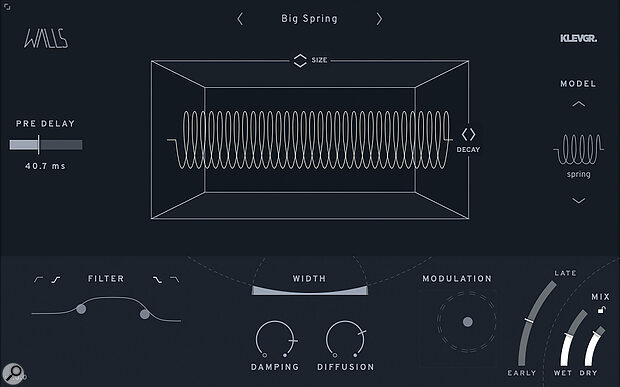The world has no shortage of decent reverb plug‑ins, but sometimes you want something that is both quick and easy to use while still being versatile, and in that case Klevgrand’s Walls might well appeal. Walls provides six different types of reverb: Spring, Plate, Hall, Cosmic, Hex and Binary, the last being a straight‑ahead algorithmic reverb. The decay time (100ms to 30 seconds) and size are adjusted by dragging the labelled arrows at the side and top of a box displaying a graphic of the currently selected reverb. There’s adjustment for pre‑delay time as well as high and low EQ, with a choice of shelving or high‑/low‑pass, and dragging two dots on the EQ curve sets the frequency and depth. In the centre are controls for damping, diffusion and width, while modulation can be added by dragging a virtual joystick dot to control both rate and depth. Curved sliders set the Early/Late balance, the Wet level and the Dry level. To the right of the main graphic is the reverb type selector.
In Operation
Operation is straightforward and each of the reverb types offers a very different tonal character. Though Spring exhibits a convincing tonality, to my ears it doesn’t sound quite twangy enough to pass for a true spring reverb — but that’s not a bad thing in my book, as I’ve always hated the twang of real springs when processing anything other than electric guitar! To my ears the Spring has a spring‑meets‑small‑plate character, and it works well on drum loops, sounding tight and with just the right amount of metallic edge. At lower density settings, the sound gets more metallic. Plate, on the other hand, sounds very much like the real thing, with a dense tail and a very subtle hint of metallic resonance. Set the decay time to two or three seconds, and it sounds very natural, but of course the maximum 30‑second decay means that it can venture into territory that no mechanical plate can.
Hall has the expected expansive character, with the reverb tail taking a short time to build up, while Cosmic seems to add more of a dynamic wash to the overall sound. Hex implies a six‑sided space (or perhaps eight, with the floor and ceiling) and it combines delays with reverb in a useful way. Set it to fully wet and with late reflections only, and you’re greeted by an extremely fluttery reverb tail. Set it to early only and you hear repeats alternating left and right. These characteristics are even more obvious at low density and/or increased mod settings. It’s not a natural reverb sound by any means, then, but it’s potentially useful, especially if you need the sound of somebody shovelling dried peas into a huge oil drum!
Lastly comes Binary, which sounds to me like a vintage digital reverb, exhibiting a slightly soft attack and a nicely shimmery, even‑sounding tail. At lower density settings, the sound takes on a vintage graininess, and this can be very flattering on non‑percussive sound sources. Binary does a workmanlike job on just about any sound source to which you simply need to add ‘a bit of wet’ and, as with a plate, it doesn’t try to suggest any specific type of space.
Walls has the advantage of simplicity plus the ability to quickly switch between six distinctly different types of reverb.
While there are many more sophisticated reverb plug‑ins available, Walls has the advantage of simplicity plus the ability to quickly switch between six distinctly different types of reverb. All the reverb types behave well at shorter decay times and all the important controls are immediately to hand with no unnecessary complications. And it’s not exactly expensive either!

